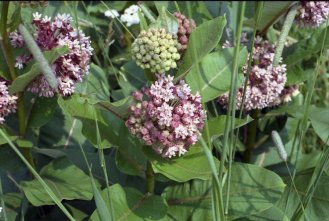
With the departure of the snow, I'm noticing all the opened milkweed seedpods along the roadsides and at the edges of my yard. It has me thinking about how they looked in July. They are such strange plants, oozing sticky bitter sap like Elmer's glue when you try (always unsuccessfully) to pull them out of your garden. These strange, fleshy flowers, the color of bruises, trap nectar-seeking insects by the leg. When the butterfly or wasp pulls its leg free, it drags out the pollinium, a pollen-filled ankle bracelet. Smaller, frailer insects, such as ants, can't extricate themselves, and they die like beavers in leghold traps.
My plant taxonomy professor told us that Linnaeus named these strange flowers Asclepias syriaca because he felt sure the North American herbarium specimens he received must have been mislabeled. The downy stems, the fleshy leaves and seed pods, these were clearly xeric adaptations found in desert plants. He opted for syriaca rather than the canadensis or virginica he used for so many North American species.
As usual, I've found a few interesting links, which I submit for your consideration.
No comments:
Post a Comment